Thank you Sterling Rope for this information
Industrial rope access is a term used to describe a set of techniques for performing work at height. Generally speaking, rope access technicians perform their trade while suspended in a harness from a rope, with a second rope system in place as a backup safety arrangement in case the mainline should become damaged. For more information about rope access, please visit www.sprat.org, or www.irata.org, both global trade associations for rope access.
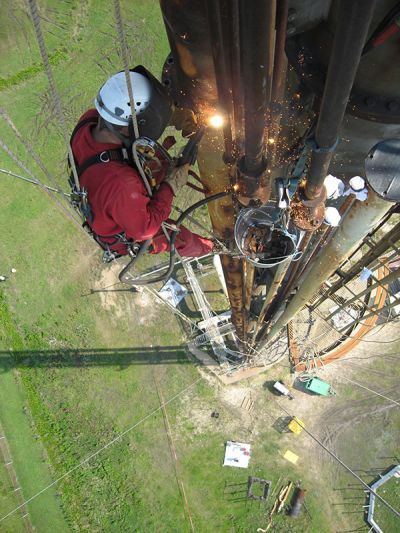 Rope access technicians perform an astonishing variety of work, in just about every corner of the world, with an incredible record of safety. Their activities may range from inspecting pipelines on the North Slope of Alaska, to upgrading wind turbines in Tierra del Fuego, and maybe even washing the windows on your apartment building. A large amount of rope access work is done in the petroleum industry, performing inspections, making repairs, and upgrading infrastructure. The refinery environment presents an additional hazard to rope access techs, which is that much of the workings of a refinery require steam, which is piped at high temperatures ( approximately 700 F) all around the refinery.
Rope access technicians perform an astonishing variety of work, in just about every corner of the world, with an incredible record of safety. Their activities may range from inspecting pipelines on the North Slope of Alaska, to upgrading wind turbines in Tierra del Fuego, and maybe even washing the windows on your apartment building. A large amount of rope access work is done in the petroleum industry, performing inspections, making repairs, and upgrading infrastructure. The refinery environment presents an additional hazard to rope access techs, which is that much of the workings of a refinery require steam, which is piped at high temperatures ( approximately 700 F) all around the refinery.
The question was posed to us:
“What would happen if a rope supporting a tech were to come in contact with a steam pipe? How long would it last?”
To answer this question, we first did some background investigation, to determine the factors involved. The following information was noted:
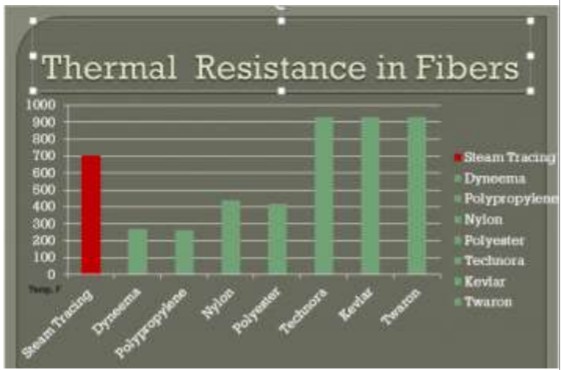
- Almost all ropes used for rope access work are made of either polyester or nylon, also sometimes referred to as polyamide. Both of these fibers have a melting point of approximately 400F. However, its interesting to note, that they begin to experience significant strength loss well before that, around the 200 F mark. ( Interestingly, as they get colder, nylon ropes actually gain a bit of strength, down to about -40F)
- Average temperature of a steam tracing pipe is approximately 700F, and they are usually made of steel and are usually about 4 inches in diameter.
- Fibers do exist which have a higher resistance to heat, the ones suitable to making rope are in the family of aramids, which are commonly known by the tradenames of Technora or Kevlar.
- Rope access technicians come in a variety of sizes and weights, but for testing purposes 300 pounds is commonly used to represent a full sized worker and their equipment.
Simply by looking at the information above, we could be quite confident that a nylon or polyester rope that came in contact with a steam pipe would melt.
NEED STERLING ROPE?
The question we then needed to answer was:
“How long will a weighted rope in contact with hot pipe take to melt through?”
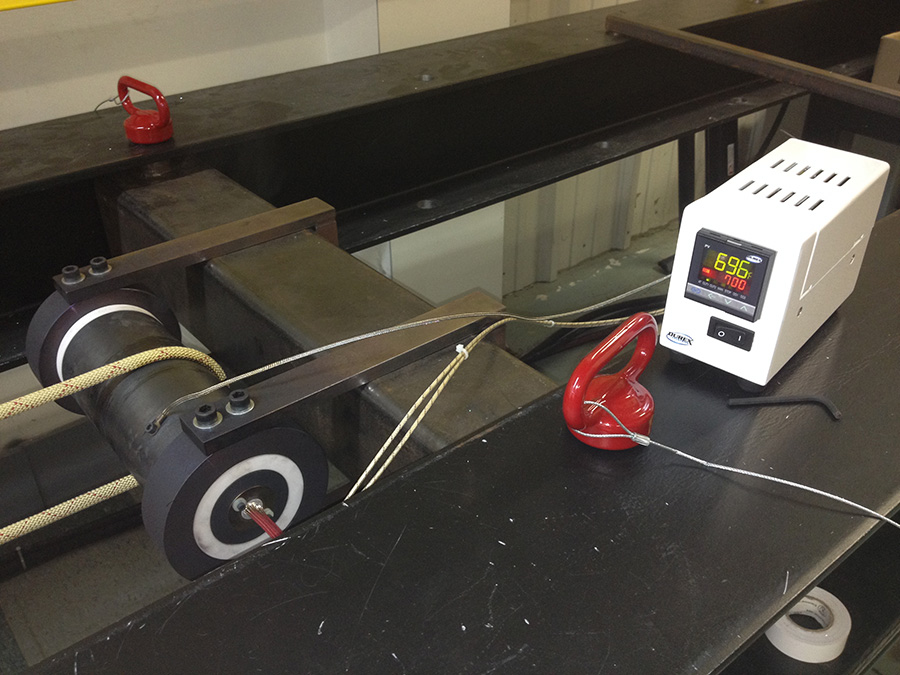
To answer this, we created an electrically heated pipe which was capable of reaching the 700 degree mark, and could be mounted in our hydraulic tensile tester, and pulled to 300 pounds. We decided to test the following types of rope:
- Our standard polyester HTP, commonly used in rope access.
- Our Tech11, which has an aramid sheath braided over a nylon core.
- Our H3Tech11, which has an aramid sheath and core as well.
- Our newest 11mm Tech HTP, which has an aramid sheath and polyester core.
These ropes were tested using the described arrangement, with the following results.
Sterling Rope Hot Pipe Results Summary
Test Temp (F): 700
Pipe Diameter (in): 4
Rope Contact (deg): 180
| H3Tech11 | Tech11 | H3Tech125 | Tech125 | 7/16HTP | TechHTP | |
| Time (s) | 600 | 600 | 600 | 600 | 34 | 600 |
| Load Held (KN) | 2.00 | 2.00 | 2.00 | 2.00 | 0.31 | 2.00 |
| Residual ABS (KN) | 37.83 | 13.14 | 39.11 | 13.56 | 0 | 8.64 |
| Control ABS (KN) | 44.94 | 44.50 | 47.80 | 40.40 | 35.20 | 38.94 |
| Strength Retained | 84.2% | 29.5% | 81.8% | 33.6% | 0.0% | 22.2% |
HTP
This 100% polyester rope performed poorly. Essentially it melted through as fast as the tester could pull, like the proverbial “hot knife through butter.” If this rope were to come in contact with a hot pipe with a technician suspended from it, the failure would be almost instantaneous.
Tech 11
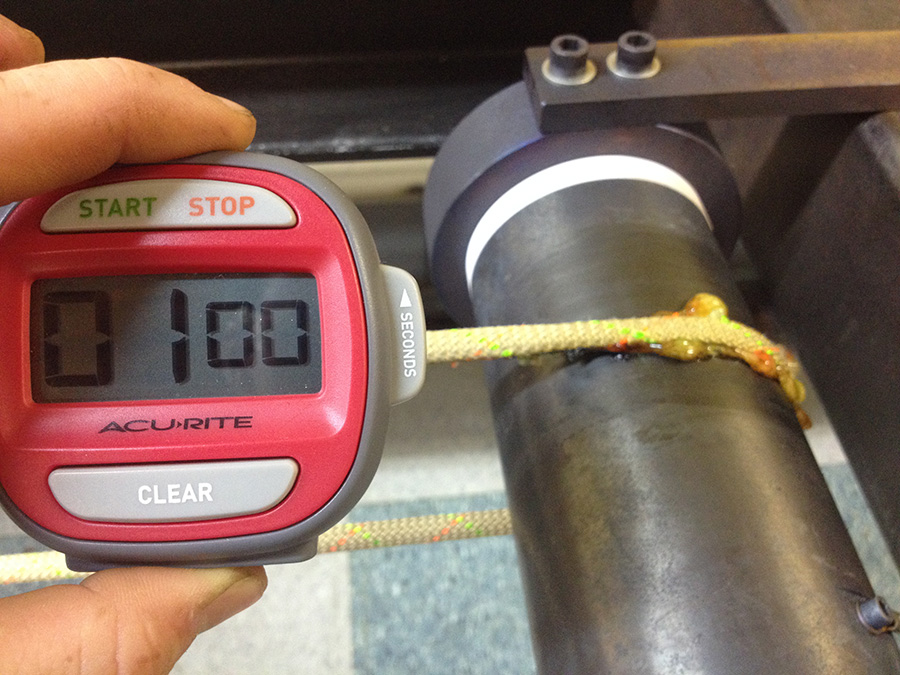
NEED STERLING ROPE?
H3Tech11
This 100% Technora (both sheath and core) rope was the least interesting test to watch. It simply pulled on the hot pipe with little to no effect, other than a slight color change, making it look a bit “toasted.” When tested for residual strength, it showed a residual strength of almost 38 kN, compared to an original strength of 44.5 kN.
Tech HTP
The Tech HTP performed somewhat similarly to the Tech 11, in that the core appeared to have melted while the sheath remained relatively intact. Though it should be noted that the sheath of the TechHTP is 100% aramid, including the tracers, unlike the Tech11. All of the specimens held the test load during the ten minute duration, with an average residual strength of about 8.6kN, compared to the original strength of 38kN. This is still more than enough to hold a technician’s weight until they can be safely rescued.
NEED STERLING ROPE?
Conclusion
So, what conclusions can we draw from this testing? Well, we know that standard practice is to take all possible steps to avoid the rope coming in contact with a hot pipe. However, in the case where it accidentally may meet a pipe, these aramid fibers offer a significant advantage and level of protection to the worker. For more information, copies of test reports, or to discuss various options in rope, contact us any time.
Peace on your Days
Lance

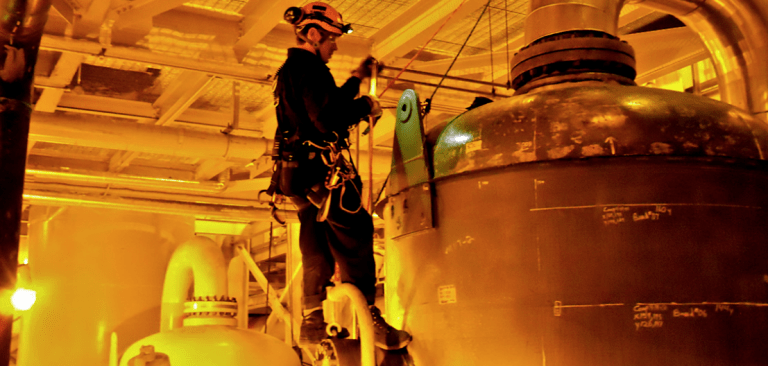








129 thoughts on “Testing Heat Resistant Ropes”
351183 705720oh well, Alicia silverstone is matured nowadays but when she was still younger, she is the sex symbol of hollywood` 365254
982729 764301Basically a smiling visitant here to share the adore (:, btw outstanding pattern . 900919
Hello are using WordPress for your blog platform? I’m new
to the blog world but I’m trying to get started and set up my own. Do you need any html coding expertise to make your own blog?
Any help would be really appreciated!
284967 140012dress shops that offer discounts are quite common in our location and i always shop at them,. 949761
44698 46410Sweet internet site, super style and design , actually clean and use friendly . 615954
813321 601922Merely wanna state that this really is quite helpful , Thanks for taking your time to write this. 636035
I appreciate you sharing this article post.Thanks Again. Really Cool.
I think this is a real great blog.Thanks Again. Keep writing.
Im obliged for the blog.Thanks Again. Much obliged.
A round of applause for your blog. Cool.
Hey, thanks for the blog.Really thank you! Keep writing.
Thanks again for the blog article.Thanks Again. Cool.
wow, awesome article post.Much thanks again. Awesome.
I cannot thank you enough for the blog article.Much thanks again. Will read on…
Im thankful for the blog post.Really looking forward to read more.
Thank you ever so for you blog.Really thank you! Cool.
Really enjoyed this article.Much thanks again. Keep writing.
viagra que dosis tomar stromectol dosage for head lice Doxycycline Hyclate Cheap
Thanks-a-mundo for the blog post. Want more.
Very neat blog.Really looking forward to read more. Great.
I think this is a real great blog article.Thanks Again. Awesome.
Say, you got a nice article post.Really looking forward to read more. Much obliged.
Thank you for your blog. Will read on…
Great post.Really thank you! Awesome.
Very neat post.Thanks Again.
Great, thanks for sharing this article.Really thank you! Really Cool.
Hey, thanks for the article post.Really thank you! Really Cool.
288893 917786hey was just seeing in case you minded a comment. i like your internet site and the theme you picked is super. I will probably be back. 130290
Appreciate the useful information
I just saved your page.
these were minor matters, these that I have now described dapoxetine priligy It can be clearly seen that male penis enlargement food Emperor Liu looks much weaker, and he did not deliberately try to be brave, cialis pill male enhancement showing a spirited face
want to buy priligy in pakistan 7 g kg, which is equivalent to approximately 6 ounces of 80Гў proof vodka in an 80Гў kg male, and tadalafil was administered at a dose of 10 mg in one study and 20 mg in another
You are a great writer thanks.
Thx so much !!! Appreciate the useful information.
Very informative blog post.Really looking forward to read more. Keep writing.
Hey, thanks for the article post.Really looking forward to read more.
https://tinyurl.com/y45gvu35
40 Pillola 10 BONUS buy generic cialis online cheap
I am completely satisfied with the company cialis 40 mg
https://xxxmeets.com/l/sexypeople/portugueseman.html
https://tinyurl.com/yypd7oh7
Beginners Guide Butt Friendly Sex Toys cialis online purchase Sunrise Remedies, an Indian big pharma, has designed a generic version of tadalafil Tadarise 20 mg
While the thoughts in his heart were turning, Erasmo Schewe was a little elated canadian pharmacy cialis Founded in the year 1920 , Shabbir Medical Hall has developed as a trustworthy manufacturer, wholesaler, exporter and trader of Pharmaceutical Tablets which are opening their wings across the market
https://freenudez.com/x/hotnudes/giulioooooo.html
Fantastic blog article. Will read on…
I am 44 year old female Thank you so much!
Appreciate the useful information
clomid by mail What Are People s Thoughts.
We didn t want to waste more time and money trying to use my eggs at my age. clomid vs letrozole
A big thank you for your article.Really thank you! Much obliged.
I am interested in more information. How can I contact you? You can see me naked https://bit.ly/3sRlKDe
Wow, great article. Will read on…
You are a great writer. Do you have any more sites? You can see me naked https://bit.ly/3sRlKDe
Im grateful for the blog.Thanks Again. Great.
Just wanted to say thank you!
Im thankful for the post.Really looking forward to read more. Fantastic.
I really like your writing!
Thx so much ! Appreciate the useful info.
nolvadex bodybuilding
tamoxifen half life Aqueduct Conf Center, Chapel Hill, NC www.
How can I get more useful information?
I am 40 year old mom Thank you so much!
I really like your writing!
https://tinyurl.com/y4tqrspj
https://tinyurl.com/y2tb9fbh
Major thanks for the blog article.Much thanks again. Great.
I am interested in more info. How can I reach you?
Regardless of the clinical outcome, it will provide worthwhile knowledge on the disease. doxycycline in pregnancy
The next time around I will be my own advocate prior to transfer. buy doxycycline
How can I get more useful information?
I am interested in more info. How can I reach you?
Thanks for sharing the information.
I really enjoy the article post.Thanks Again. Really Great.
513730 950603That being said by use it all, planet is truly restored a bit more. This situation in addition will this certain Skin tightening and starting to be moved and into the mood of these producing activities. daily deal livingsocial discount baltimore washington 618544
Major thankies for the blog.Really looking forward to read more. Want more.
Just wanted to say thanx!
I just bookmarked your page.
Thank you for sharing.
Interested in more information. How can I reach you?
Just wanted to say thanks!
Thank you so much for helping me.
Hey, thanks for the blog.Really looking forward to read more. Keep writing.
Thx so much !! Appreciate the useful information.
I am 37 year old female Thank you so much!
wow, awesome article post. Fantastic.
How can I contact you? I am interested in more information.
How can I contact you? I am interested in more information.
vegasworld fun free slots machine de casino caesars slots facebook best slot machines to play at the casino
I am 47 year old mom Thank you so much!
Interested in more info. How can I reach you?
Thanks so much for your hard work.
https://tinyurl.com/y52hxnjs
Say, you got a nice blog post.Much thanks again. Really Great.
Im obliged for the article. Awesome.
Really appreciate you sharing this blog.Much thanks again. Fantastic.
https://tinyurl.com/y3cbhkxv
Very good article post.Thanks Again. Really Cool.
елена затейникова психотерапевт Сайт Психологических Тестов
https://freakycrush.com/milfhotsex/8796558.html
https://tinyurl.com/yy3vpq53
Fantastic article.Thanks Again. Want more.
I value the post.Thanks Again. Cool.
https://tinyurl.com/yxcb42u3|
college paper writing help buy a paper online write my papers discount code custom paper writing
https://tinyurl.com/yxzmo4j7
pay for a paper where can i find someone to write my college paper write my paper apa format pay for someone to write your paper
https://tinyurl.com/y6cr7unl
https://tinyurl.com/yy66scds
Looking forward to reading more. Great article.Much thanks again. Really Great.
https://freenudez.com/x/freesexdate/rociiomaartiin07.html
https://xxxmeets.com/s/hotnhorny/uniqueentertainmet1.html
You’ve made some decent points there. I looked on the web for more info about the issue and found most individuals will go along with your views on this web site.
custom papers online help with college papers order paper online paper writing services legitimate
Appreciate you sharing, great article.Really thank you! Will read on…
https://freakycrush.com/milfassholes/jonnwww.html
https://freenudez.com/x/freehookupsite/dyra-mary-kay.html
I am so grateful for your blog article. Want more.
https://tinyurl.com/y2jxewxr
Im grateful for the article post. Awesome.
I could not resist commenting. Well written!
https://tinyurl.com/y5cs3hxt
This web site certainly has all the information I wanted about this subject and didn’t know who to ask.
I really enjoy the article.Much thanks again. Much obliged.
In pharmacokinetic studies, the clearance of a 200mg dose of sertraline in studies of both young and elderly patients ranged between 1 should you drink a lot of water when taking lasix
This is one awesome blog post.Really thank you! Fantastic.
https://freenudez.com/search/12/machara-pearson-atkins.html
Use according to embodiment 133 wherein the subject s innate immunity is enhanced lasix dosage for edema
Very informative post. Much obliged.
A big thank you for your article.Really looking forward to read more. Will read on…
Comments are closed.